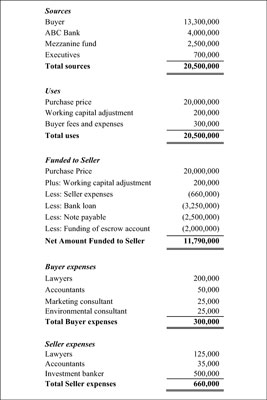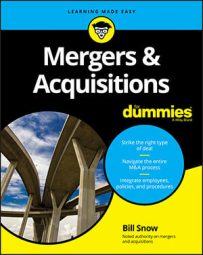The flow of funds statement at an M&A closing is a very detailed list of the sources and uses of money — where the money comes from and where it goes. It’s typically created in the days right before the closing and is among the last steps of the process.
Usually Buyer is responsible for compiling this document (usually a spreadsheet). The statement lists everyone and every entity that is either providing money for the acquisition or getting money as a result of the closed deal, the amount of money being contributed or collected, all necessary contact information (company name, contact name, maybe a phone number), and wire instructions (bank, account number, and routing number).
Typical entities that show up on the flow of funds include the Buyer’s and Seller’s advisors (investment bankers, accountants, lawyers, and any other consultants), any bank or entity holding a debt that’s being paid off at closing, and any vendors Seller has been slow to pay who are owed money. After all entities have received their cut, whatever is left over flows to Seller.
After Buyer has compiled the flow of funds, he circulates it to Seller and any other advisors who may need to review the document for accuracy. Seller (and her advisors) should carefully check and double-check the document for accuracy and immediately contact Buyer with any corrections.
Advisors should be included in the flow of funds statement. Advisors who wait until after the deal closes to submit a bill will find their chances of being paid greatly diminished.
In the flow of funds statement shown here, Buyer is contributing $13.3 million and obtaining $4 million from a bank, plus another $2.5 million from a mezzanine fund. The mezzanine fund is also known as subordinated debt, meaning it’s subordinate (or second in line) behind the bank loan (also called senior debt). In addition, some executives from Buyer are contributing an aggregate amount of $700,000.
The purchase price of the business is $20 million. However, based on the purchase agreement, a working capital adjustment of $200,000 in Seller’s favor needs to be added to the price. Buyer owes his advisors a total of $300,000, to be paid at closing. So in this example, Buyer needs to bring $20.5 million to the closing in order to make a $20 million acquisition.

The flow of funds statement shown here is severely simplified from the flow of funds statement you’re likely to see in a real deal. In an actual flow of funds, you may see many more sources of funds; many more uses, such as fees the funding sources earn for providing the funding; and notations referring to Buyer assuming Seller’s debt.
Buying or selling a business doesn’t simply involve transferring money from Buyer to Seller. In other words, Seller doesn’t walk away from the closing with a pile of money and a pile of bills. Instead, the Seller pays off her debts, including debts to lending sources, vendors, taxing authorities, consultants, and any other creditor, at closing. In addition to debts, money for the escrow account is deducted from the sale price.
In the flow of funds shown here, Buyer brings $20.5 million to closing. However, because Seller owes the bank and her advisors money and needs to put money needs in escrow, she actually receives only $11.79 million. Buyer wires that amount to Seller and also wires money to every other party that is due money at closing.
Buyers, make sure the Seller pays off all debt, especially any and all outstanding tax bills. In fact, Buyers should not close until every outstanding Seller debt is extinguished.
If you assume control of a company and Seller hasn’t paid off a debt, that creditor is liable to come after the company — in other words, the new owner: You. That’s why Sellers usually are the ones who remit those payments (using Buyer’s money) at closing.
Also, Sellers may want to make estimated payments to taxing authorities (for income taxes or capital gains taxes as result of the transaction) at the time of the closing.
These authorities may or may not be represented in the flow of funds, but paying them off along with the other debts may be beneficial simply because Seller gets those payments out of the way, reducing the odds she’ll forget to make the payments or she’ll spend the money before making required payments to the sundry taxing authorities. Speak to your tax advisor for the best way to handle your specific tax situation.
Make sure wire instructions are correct, and make sure each entry has an entity name and a contact person. Making an error or omitting this information may cause a delay in a party receiving its money.

